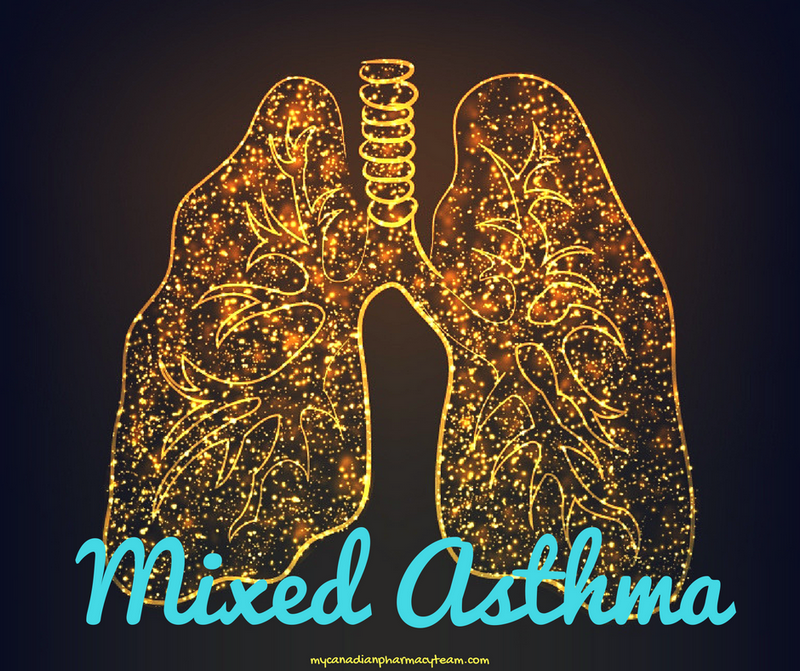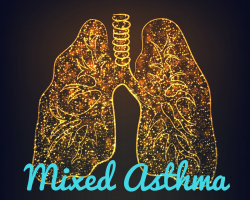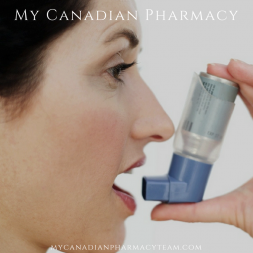The mixed form of asthma is a type of asthma, which etiology combines atopic (allergic) and non-allergic factors. Most often mixed type occurs as atopic but with bacterial sensitization. Exacerbating factors can be other non-allergic causes: poisoning, stress, endocrine disease, etc.

Clinical Picture
The mixed form of the disease is characterized by acute polymorphism, progressive development, seizures increased in frequency and duration with a high probability of transition to asthmatic condition, problems with relieving attacks. The possibility of complications increases: pneumothorax, pulmonary heart disease, atelectasis. The clinical picture of mixed asthma often points to the prevalence of bacterial nature of bronchial sensitization. There is a direct link between hypothermia and aggravation of background infectious diseases, and aggravation itself has signs of infection such as asthma symptoms (low-grade fever, the general intoxication of the body).
At the same time, additional sensitization, caused by allergens that are not related to infection, leaves its mark on disease course. In between long asthma attacks of infectious nature there appear severe allergic, but short-term, symptoms such as severe dyspnea without changing body temperature. Such exacerbations are easily eliminated by receiving bronchodilators.
People affected by the mixed type of asthma, observe multiple foci of infection: in the pulmonary system, ENT-system, digestive organs. At the same time causes of atopic type are determined: genetic predisposition, allergic diseases (allergic rhinitis, dermatitis), drug and other types of allergy. Peripheral blood composition shows features of this disease type. Blood serum analysis reveals elevated levels of IgE and specific antibodies content, content and decrease of T-lymphocytes, T-suppressor is observed.
Pathology Classification
Asthma classification is made taking into account disease course severity and main feature severity (suffocation). The degree of respiratory failure (degree of status asthmaticus) is divided into 3 phases:
- Mild phase. Dyspnea occurs only during walking, no difficulties with speech.
- Middle phase. Dyspnea is noticeable during speaking, discomfort in lying position, which makes it necessary to sit, without additional inhale only short sentences can be said.
- Severe phase. Respiratory insufficiency at rest, necessity to inhale arises after 1 – 2 spoken words, forced posture – sitting leaning forward.
Disease severity is divided into the following categories:
Step 1: episodic (intermittent) form. Attacks occur during the day not more than 4 times per month, and at night – 2 times a month, aggravation has a short duration.
Step 2: mild persistent form, when day exacerbations appear 2 – 7 times a week, night attacks – more than 2 times a month, there is insomnia due to breathing, problems with physical activity.
Stage 3: persistent mixed type asthma of moderate severity, at which day-time attacks happen every day, at night – more than 1 time in 4 days, there is a decrease in physical activity.
Stage 4: severe persistent asthma (repeated exacerbations during the day, frequent nocturnal attacks, significant deterioration in general health condition and reduced working capacity).
Disease Diagnosis
The doctor makes a primary diagnosis by characteristic dyspnea and respiratory failure after examination and studying anamnesis. Pathology differentiation by its type is carried out by therapist, pulmonologist and allergist. X-rays, ultrasound, electrocardiogram, spirometry, peakflowmetry (peak expiratory flow) are conducted to establish the final diagnosis. It is mandatory to carry out blood and sputum laboratory tests. Sometimes skin tests are carried out to establish the type of allergen.
Pathology Treatment
Mixed asthma treatment is carried out by methods using an integrated approach. Therapy is carried out in two directions: symptomatic and systematic.
Primary role is played by an attack and respiratory failure elimination, removing inflammatory reactions, asthma complications prevention.
Symptomatic Therapy
Drugs for symptomatic treatment provide spasms elimination (bronchodilators) and normalization of bronchial patency. The following products are recommended for such tasks:
- glucocorticosteroids (triamcinolone, prednisolone, dexamethasone);
- beta2-agonists of rapid action (salbutamol, terbutaline);
- antiholin-energetics (ipratropium bromide);
- short-acting theophylline.
For rapid relief of sudden attacks, mentioned means are applied in the form of aerosols and inhalers. They should have rapid action and remove aggravation within a few minutes. For quick relief, the concentration of active ingredients in preparations is significantly increased. In connection with some of their toxic effects, an application is allowed only in case of emergency.
 Systemic Therapy
Systemic Therapy
Basic treatment is carried out with long-acting preparations. They do not have an instant effect and are intended for long-term course application. Systemic therapy is carried out by the following means:
- non-steroidal anti-inflammatory drugs (nedocromil and sodium cromoglicate);
- aerosol corticosteroids (triamcinolone acetonide, budesonide, fluticasone propionate);
- long-acting beta2-agonists (salmeterol);
- leukotriene receptor antagonists (montelukast, zafirlukast).
In addition to drug therapy for mixed asthma treatment of moderate severity therapeutic acupressure massage, special breathing exercises, physical therapy are actively used. They relieve asthma attacks, help normalize breathing.
Posted by Dr. Himanshu Singh

 English
English Deutsch
Deutsch Français
Français Italiano
Italiano Español
Español Svenska
Svenska Português
Português 日本人
日本人 Dansk
Dansk Norsk
Norsk Suomi
Suomi Czech
Czech


